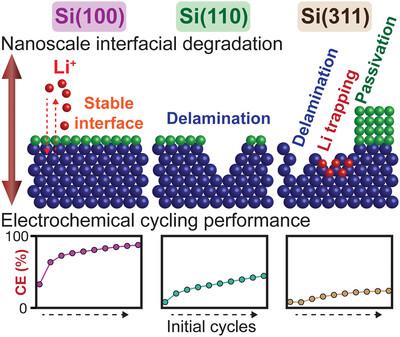Link between anisotropic electrochemistry and surface transformations at single‐crystal silicon electrodes: Implications for lithium‐ion batteries
IF 3.1
Q2 MULTIDISCIPLINARY SCIENCES
引用次数: 3
Abstract
Silicon is a promising negative electrode material for high-energy-density Li-ion batteries (LiBs) but suffers from significant degradation due to the mechanical stress induced by lithiation. Volume expansion and lithiation in Si are strongly anisotropic but associated early interfacial transformations linked to these phenomena and their implications for electrode performance remain poorly understood. Here we develop a novel correlative electrochemical multi-microscopy approach to study local interfacial degradation at the early stages for three different surface orientations of Si single crystals: Si(100), Si(110) and Si(311), after Li-ion electrochemical cycling. The experimental strategy combines scanning electrochemical cell microscopy (SECCM) measurements with subsequently recorded scanning transmission electron microscopy images of high-quality cross sections of Si electrodes, extracted at selected SECCM regions, using a novel Xe + plasma-focused ion beam procedure. These studies reveal significant surface orientation–dependent nanoscale degradation mechanisms that strongly control electrode performance. Si(100) was immune to interfacial degradation showing the best lithiation reversibility, whereas local nanoscale delamination was observed in Si(110) leading to a lower Coulombic efficiency. Continuous electrochemical deactivation of Si(311) was associated with delamination across the whole interface, Li trapping and formation of thick (ca. 60 nm) SiO 2 structures. These results demonstrate surface crystallography to be a critical factor when designing Si-based

单晶硅电极的各向异性电化学和表面转化之间的联系:对锂离子电池的影响
硅是一种很有前途的高能量密度锂离子电池(LiBs)负极材料,但由于锂化引起的机械应力而严重退化。Si中的体积膨胀和锂化具有很强的各向异性,但与这些现象相关的早期界面转变及其对电极性能的影响仍然知之甚少。在这里,我们开发了一种新的相关电化学多显微方法来研究三种不同表面取向的Si单晶:Si(100), Si(110)和Si(311)在锂离子电化学循环后的早期局部界面降解。实验策略结合了扫描电化学电池显微镜(SECCM)测量和随后记录的高质量Si电极横截面的扫描透射电子显微镜图像,在选定的SECCM区域提取,使用新颖的Xe +等离子体聚焦离子束程序。这些研究揭示了表面取向依赖的纳米级降解机制,这些机制强烈地控制着电极的性能。Si(100)不受界面降解的影响,具有最佳的锂化可逆性,而Si(110)中存在局部纳米级分层,导致库仑效率较低。Si(311)的持续电化学失活与整个界面的分层、Li捕获和厚(约60 nm) sio2结构的形成有关。这些结果表明,在设计硅基材料时,表面晶体学是一个关键因素
本文章由计算机程序翻译,如有差异,请以英文原文为准。
求助全文
约1分钟内获得全文
求助全文

 求助内容:
求助内容: 应助结果提醒方式:
应助结果提醒方式:


